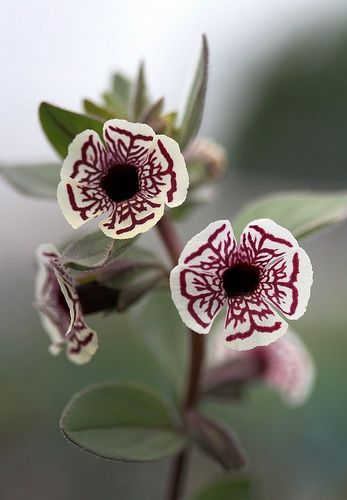Interesting Plant: Calico Monkeyflower (Mimulus pictus)
I am quite familiar with our local native mimulus, but this is quite, quite different. The striking coloration and deep, dark center are quite amazing.

Discovered via Tumblr User, flowersgardenlove
Mimulus pictus is a species of monkeyflower known by the common name calico monkeyflower. It is endemic to central California, where it is known only from the southernmost Sierra Nevada and adjacent Tehachapi Mountains in Tulare and Kern Counties. It grows in forest and woodland habitat, in open, bare, rocky, and often disturbed areas. This is an annual herb growing in a small patch at ground level or erect to a maximum height of about 38 centimeters. The stem is hairy and rectangular in cross-section. The oppositely arranged leaves are somewhat oval in shape and up to 4.5 centimeters long. The tubular base of the flower is encapsulated in a dark reddish calyx of sepals with uneven lobes. The five-lobed flower has a maroon throat and the circular face is white with stark maroon veining. — Wikipedia.org
More on Mimulus…
Most of the species are annuals or herbaceous perennials, but a few species are subshrubs with woody stems; these are treated in the section Diplacus. Diplacus is clearly derived from within Mimulus s.l. and was not usually considered to be generically distinct. Hence, it would not be treated as a genus separate from Mimulus now, though it might become a section of a yet-to-be defined split from Mimulus s.str.. A large number of the species grow in moist to wet soils with some growing even in shallow water. Some species produce copious amounts of aromatic compounds, giving them a musky odor (hence “musk-flowers”).
Mimulus are called monkey-flowers because some species have flowers shaped like a monkey’s face.[3] The generic name, Latin mimus meaning “mimic actor”, from the Greek mimos meaning “imitator” also references this. The stem of a few species of Mimulus can be either smooth or hairy, and this trait is determined by a simple allelic difference.[verification needed] At least M. lewisii is known to possess “flypaper-type” traps and is apparently protocarnivorous, supplementing itsnutrients with small insects. — Wikipedia
More information on Monkeyflower (Mimulus pictus):
- Monkeyflower (Mimulus pictus) at Wikipedia
- Monkeyflower (Mimulus pictus) at Annie’s Annuals
- Monkeyflower (Mimulus pictus) at CalPhotos
Previously in the Interesting Plant series:
- Colocasia Esculenta
- Acer palmatum ‘Sango-kaku’ (Coral Bark Japanese Maple)
- Linderniaceae (formerly Torenia) Kuaui Deep Blue
- Passiflora (Passion flower)
- Firewheel Tree (Stenocarpus sinuatus)
- Anemone
- Allium Cowanii
- Symphyotrichum oblongifolius (Purple Aster)
- Hemerocallis ‘Derrick Cane’ (Daylily)
- Agastache ‘Aztec Rose’
- Rudbeckia hirta Moreno
- Kalanchoe Tomentosa
- Albuca namaquensis
- Hosta ‘Remember Me’
- Dahlia ‘Clair de Lune’
- Lovely silver-tinged fern on campus of Oberlin College, Ohio
- Tricolor Beech (Fagus sylvatica Purpurea Tricolor)
- Climbing Hydrangea (Hydrangea anomala petiolaris)
- Eremurus ‘Lemon Meringue’
- Lupine “Sunrise” (Lupinus hartwegii)
- Chinese Fringe Flower (Loropetalum chinense)
- Streptocarpus ‘Harlequin Blue’
- Nigella damascena (love-in-a-mist, ragged lady)
- Epiphyllum (Orchid Cactus)
- Sempervivum ‘Westerlin’
- Gladiolus ‘Kings Lynn’
- Hosta sieboldiana ‘Dorothy Benedict’
- Begonia “Escargot”
- Asparagus Pea (Psophocarpus tetragonolobus)
- Rosa banksiae (Lady Banks’ Rose)
- Primula ‘Victoriana Silver Laced Black’
- Oxalis versicolor
- Poached Egg Plant (Limnanthes douglasii)
- Parisian Carrots
- Fritillaria imperialis Rubra Maxima
- Clematis “Fascination”
- Swiss Chard “Bright Lights”
- Georgia Rattlesnake Melon
- Dianthus Barbathus “Green Ball” or “Green Trick”
- Coleus “Religious Radish”
- Black Forest Calla Lily
- Black Bamboo
Interesting Plant is a series from A Gardener’s Notebook blog and podcast that highlights the most interesting plants I find in my Internet and real-world travels — Douglas





